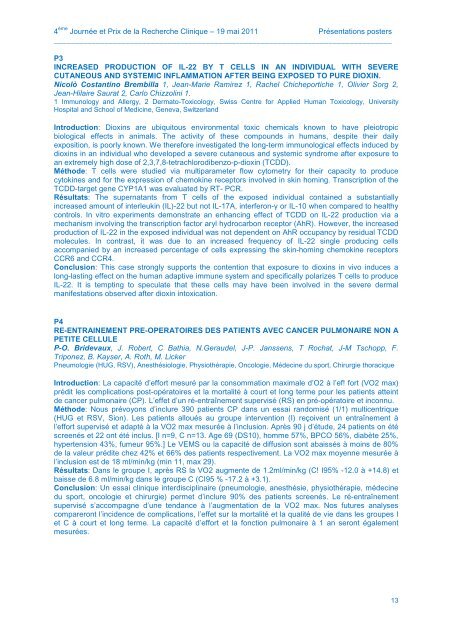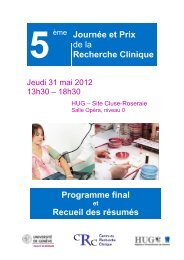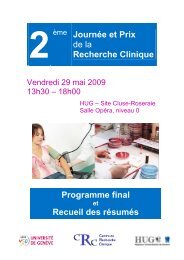Programme final et Recueil des résumés - Centre de recherche ...
Programme final et Recueil des résumés - Centre de recherche ...
Programme final et Recueil des résumés - Centre de recherche ...
Create successful ePaper yourself
Turn your PDF publications into a flip-book with our unique Google optimized e-Paper software.
4 ème Journée <strong>et</strong> Prix <strong>de</strong> la Recherche Clinique – 19 mai 2011 Présentations posters<br />
________________________________________________________________________________<br />
P3<br />
INCREASED PRODUCTION OF IL-22 BY T CELLS IN AN INDIVIDUAL WITH SEVERE<br />
CUTANEOUS AND SYSTEMIC INFLAMMATION AFTER BEING EXPOSED TO PURE DIOXIN.<br />
Nicolò Costantino Brembilla 1, Jean-Marie Ramirez 1, Rachel Chicheportiche 1, Olivier Sorg 2,<br />
Jean-Hilaire Saurat 2, Carlo Chizzolini 1.<br />
1 Immunology and Allergy, 2 Dermato-Toxicology, Swiss <strong>Centre</strong> for Applied Human Toxicology, University<br />
Hospital and School of Medicine, Geneva, Switzerland<br />
Introduction: Dioxins are ubiquitous environmental toxic chemicals known to have pleiotropic<br />
biological effects in animals. The activity of these compounds in humans, <strong><strong>de</strong>s</strong>pite their daily<br />
exposition, is poorly known. We therefore investigated the long-term immunological effects induced by<br />
dioxins in an individual who <strong>de</strong>veloped a severe cutaneous and systemic syndrome after exposure to<br />
an extremely high dose of 2,3,7,8-t<strong>et</strong>rachlorodibenzo-p-dioxin (TCDD).<br />
Métho<strong>de</strong>: T cells were studied via multiparam<strong>et</strong>er flow cytom<strong>et</strong>ry for their capacity to produce<br />
cytokines and for the expression of chemokine receptors involved in skin homing. Transcription of the<br />
TCDD-targ<strong>et</strong> gene CYP1A1 was evaluated by RT- PCR.<br />
Résultats: The supernatants from T cells of the exposed individual contained a substantially<br />
increased amount of interleukin (IL)-22 but not IL-17A, interferon-γ or IL-10 when compared to healthy<br />
controls. In vitro experiments <strong>de</strong>monstrate an enhancing effect of TCDD on IL-22 production via a<br />
mechanism involving the transcription factor aryl hydrocarbon receptor (AhR). However, the increased<br />
production of IL-22 in the exposed individual was not <strong>de</strong>pen<strong>de</strong>nt on AhR occupancy by residual TCDD<br />
molecules. In contrast, it was due to an increased frequency of IL-22 single producing cells<br />
accompanied by an increased percentage of cells expressing the skin-homing chemokine receptors<br />
CCR6 and CCR4.<br />
Conclusion: This case strongly supports the contention that exposure to dioxins in vivo induces a<br />
long-lasting effect on the human adaptive immune system and specifically polarizes T cells to produce<br />
IL-22. It is tempting to speculate that these cells may have been involved in the severe <strong>de</strong>rmal<br />
manifestations observed after dioxin intoxication.<br />
P4<br />
RE-ENTRAINEMENT PRE-OPERATOIRES DES PATIENTS AVEC CANCER PULMONAIRE NON A<br />
PETITE CELLULE<br />
P-O. Bri<strong>de</strong>vaux, J. Robert, C Bathia, N.Gerau<strong>de</strong>l, J-P. Janssens, T Rochat, J-M Tschopp, F.<br />
Triponez, B. Kayser, A. Roth, M. Licker<br />
Pneumologie (HUG, RSV), Anesthésiologie, Physiothérapie, Oncologie, Mé<strong>de</strong>cine du sport, Chirurgie thoracique<br />
Introduction: La capacité d’effort mesuré par la consommation maximale d’O2 à l’ef! fort (VO2 max)<br />
prédit les complications post-opératoires <strong>et</strong> la mortalité à court <strong>et</strong> long terme pour les patients atteint<br />
<strong>de</strong> cancer pulmonaire (CP). L’eff<strong>et</strong> d’un ré-entraînement supervisé (RS) en pré-opératoire <strong>et</strong> inconnu.<br />
Métho<strong>de</strong>: Nous prévoyons d’inclure 390 patients CP dans un essai randomisé (1/1) multicentrique<br />
(HUG <strong>et</strong> RSV, Sion). Les patients alloués au groupe intervention (I) reçoivent un entraînement à<br />
l’effort supervisé <strong>et</strong> adapté à la VO2 max mesurée à l’inclusion. Après 90 j d’étu<strong>de</strong>, 24 patients on été<br />
screenés <strong>et</strong> 22 ont été inclus. [I n=9, C n=13. Age 69 (DS10), homme 57%, BPCO 56%, diabète 25%,<br />
hypertension 43%, fumeur 95%.] Le VEMS ou la capacité <strong>de</strong> diffusion sont abaissés à moins <strong>de</strong> 80%<br />
<strong>de</strong> la valeur prédite chez 42% <strong>et</strong> 66% <strong><strong>de</strong>s</strong> patients respectivement. La VO2 max moyenne mesurée à<br />
l’inclusion est <strong>de</strong> 18 ml/min/kg (min 11, max 29).<br />
Résultats: Dans le groupe I, après RS la VO2 augmente <strong>de</strong> 1.2ml/min/kg (C! I95% -12.0 à +14.8) <strong>et</strong><br />
baisse <strong>de</strong> 6.8 ml/min/kg dans le groupe C (CI95 % -17.2 à +3.1).<br />
Conclusion: Un essai clinique interdisciplinaire (pneumologie, anesthésie, physiothérapie, mé<strong>de</strong>cine<br />
du sport, oncologie <strong>et</strong> chirurgie) perm<strong>et</strong> d’inclure 90% <strong><strong>de</strong>s</strong> patients screenés. Le ré-entraînement<br />
supervisé s’accompagne d’une tendance à l’augmentation <strong>de</strong> la VO2 max. Nos futures analyses<br />
compareront l’inci<strong>de</strong>nce <strong>de</strong> complications, l’eff<strong>et</strong> sur la mortalité <strong>et</strong> la qualité <strong>de</strong> vie dans les groupes I<br />
<strong>et</strong> C à court <strong>et</strong> long terme. La capacité d’effort <strong>et</strong> la fonction pulmonaire à 1 an seront également<br />
mesurées.<br />
13






